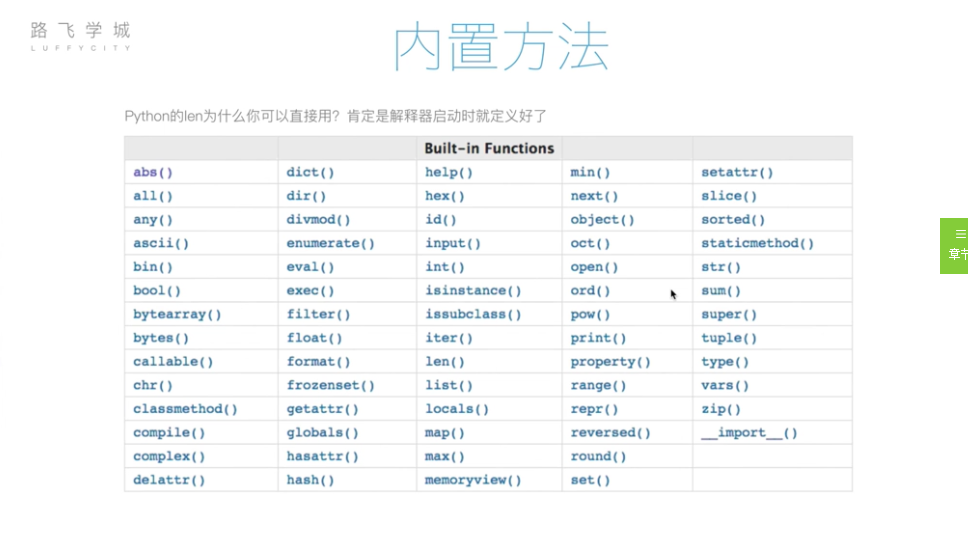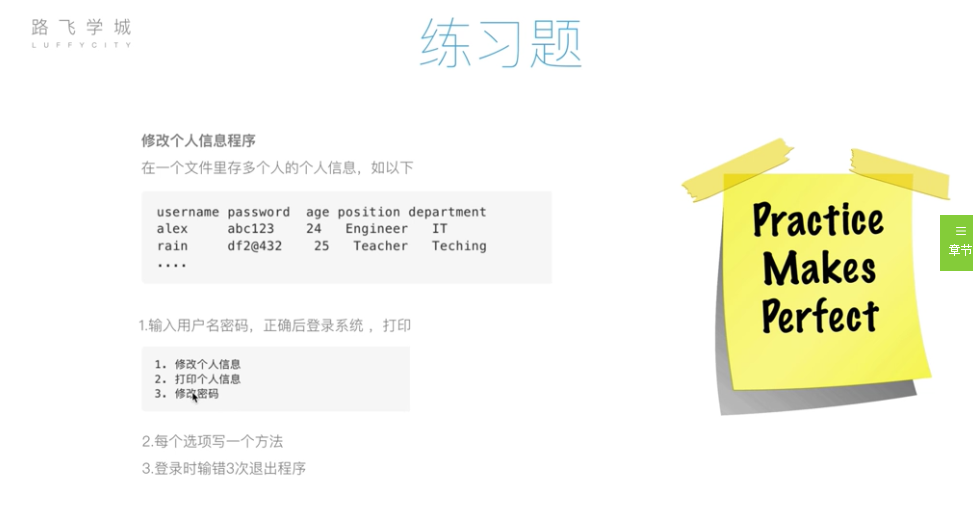1 # abs 绝对值
2 print(abs(-11)) #结果为:11
3
4 #dict 将一些数据转换为字典类型
5 #help 查看帮助
6
7 #min 返回最小值 max 返回最大值
8 a =[1,4,5,-1,3]
9 print(min(a)) #结果为:-1
10 print(max(a)) #结果为:5
11
12 # all 列表里面所有的值都为 True 则返回 True(0、False为 False)
13 print(all(a)) #结果为:True
14
15 print(bool(0)) #结果为:False
16 print(bool(False)) #结果为:False
17 print(bool(-1)) #结果为:True
18
19 print(bool([])) #结果为:False
20 print(all([])) #结果为:True
21
22 # any 列表里面有一个值为 True 则返回 True(0、False为 False)
23 a =[1,4,5,-1,0]
24 print(any(a)) #结果为:True
25
26 #dir 打印当前程序中存在的所有变量
27 print(dir()) #结果为:['__annotations__', '__builtins__', '__cached__', '__doc__', '__file__', '__loader__', '__name__', '__package__', '__spec__', 'a']
28
29 #hex 将十进制数值转换为16进制
30 print(hex(12)) #结果为:0xc
31
32 #slice 切片
33 s = slice(1,7,2)
34 li = list(range(10))
35 print(li) #结果为:[0, 1, 2, 3, 4, 5, 6, 7, 8, 9]
36 print(s) #结果为:slice(1, 7, 2)
37 print(li[1:3]) #结果为:[1, 2]
38 print(li[s]) #结果为:[1, 3, 5]
39
40 #divmod 返回商和余数
41 print(divmod(10,3)) #结果为:(3, 1)
42
43 #sorted 排序
44 li = [0, 1, 2, 3, 99, 81, 4, 5, 6, 7, 8, 9]
45 print(li) #结果为:[0, 1, 2, 3, 99, 81, 4, 5, 6, 7, 8, 9]
46 print(sorted(li)) #结果为:[0, 1, 2, 3, 4, 5, 6, 7, 8, 9, 81, 99]
47 #字典是无序的
48 d = { }
49 for i in range(20):
50 d[i] = i - 50
51 print(d) #结果为:{0: -50, 1: -49, 2: -48, 3: -47, 4: -46, 5: -45, 6: -44, 7: -43, 8: -42, 9: -41, 10: -40, 11: -39, 12: -38, 13: -37, 14: -36, 15: -35, 16: -34, 17: -33, 18: -32, 19: -31}
52 print(d.items()) #结果为:dict_items([(0, -50), (1, -49), (2, -48), (3, -47), (4, -46), (5, -45), (6, -44), (7, -43), (8, -42), (9, -41), (10, -40), (11, -39), (12, -38), (13, -37), (14, -36), (15, -35), (16, -34), (17, -33), (18, -32), (19, -31)])
53 print(sorted(d.items())) #结果为:[(0, -50), (1, -49), (2, -48), (3, -47), (4, -46), (5, -45), (6, -44), (7, -43), (8, -42), (9, -41), (10, -40), (11, -39), (12, -38), (13, -37), (14, -36), (15, -35), (16, -34), (17, -33), (18, -32), (19, -31)]
54 print(sorted(d.items(),key = lambda x:x[1])) #结果为:[(0, -50), (1, -49), (2, -48), (3, -47), (4, -46), (5, -45), (6, -44), (7, -43), (8, -42), (9, -41), (10, -40), (11, -39), (12, -38), (13, -37), (14, -36), (15, -35), (16, -34), (17, -33), (18, -32), (19, -31)]
55 d[0] = 299
56 print(sorted(d.items(),key = lambda x:x[1])) #最大值在最后面 结果为:[(1, -49), (2, -48), (3, -47), (4, -46), (5, -45), (6, -44), (7, -43), (8, -42), (9, -41), (10, -40), (11, -39), (12, -38), (13, -37), (14, -36), (15, -35), (16, -34), (17, -33), (18, -32), (19, -31), (0, 299)]
57 print(sorted(d.items(),key = lambda x:x[1],reverse=True)) #最大值在最前面 结果为:[(0, 299), (19, -31), (18, -32), (17, -33), (16, -34), (15, -35), (14, -36), (13, -37), (12, -38), (11, -39), (10, -40), (9, -41), (8, -42), (7, -43), (6, -44), (5, -45), (4, -46), (3, -47), (2, -48), (1, -49)]
58
59 #ascii 将字符转成二进制
60 s = 'abcd路飞'
61 print(s) #结果为:abcd路飞
62 print(ascii(s)) #结果为:'abcdu8defu98de'
63
64 #enumerate 枚举,返回列表的索引
65
66 # oct 将10进制转换成为8进制
67 print(oct(12)) #结果为:0o14
68
69 # bin 将10进制转换成为2进制;
70 print(bin(12)) #结果为:0b1100
1 #eval exec 将字符串转成数字
2 f = '1+3/2'
3 print(f) #结果为:1+3/2
4 print(eval(f)) #结果为:2.5
5 code = """
6 def foo():
7 prinr("run foo")
8 return 1234
9 foo()
10 """
11 res = eval("1+3+3")
12 res2 = exec("1+3+3")
13 print('res',res) #结果为:res 7
14 print('res',res2) #结果为:res None
15 # 小结;
16 # eval只能处理单行代码,而exec可以处理多行代码;
17 # 但exec没有返回值,eval有返回值;
18
19 #ord 返回在ASCII码表中的位置 chr 通过ASCII码表中的位置,返回字符
20 print(ord('a')) #结果为:97
21 print(ord('b')) #结果为:98
22 print(chr(97)) #结果为:a
23 print(chr(98)) #结果为:b
24
25 #sum 求列表中元素的和
26 a =[1,4,5,-1,3,0]
27 print(sum(a)) #结果为:12
28
29 #bytearray
30 print(a) #结果为:[1, 4, 5, -1, 3, 0]
31 s = 'abcd路飞'
32 print(s) #结果为:abcd路飞
33 print(s[0]) #结果为:a
34 #s[0]='A'
35 #print(s[0]) #结果为:TypeError: 'str' object does not support item assignment
36 #s2 = bytearray(s) #结果为:TypeError: string argument without an encoding
37 s = s.encode('utf-8')
38 print(s[0]) #结果为:97
39 #s[0] =98 #结果为:TypeError: 'bytes' object does not support item assignment
40 s = bytearray(s)
41 print(s[0]) #结果为:97
42 s[0] = 65
43 print(s) #结果为:bytearray(b'Abcdxe8xb7xafxe9xa3x9exe5xadxa6xe5x9fx8e')
44 print(s[4]) #结果为:232
45 s[4]=233
46 print(s) #结果为:bytearray(b'Abcdxe8xb7xafxe9xa3x9exe5xadxa6xe5x9fx8e')
47 print(s.decode()) #结果为:Abcd鷯飞学城
48 print(id(s)) #结果为:1987262190008
49 s[0]=66
50 print(id(s)) #结果为:1987262190008
51
52 #map filter(过滤) reduce 三剑客
53 print(map(lambda x: x*x , [1,2,3,4,5])) #结果为:<map object at 0x0000022DB38384A8>
54 print(list(map(lambda x: x*x , [1,2,3,4,5]))) #结果为:[1, 4, 9, 16, 25]
55
56 print(filter(lambda x: x>3 , [1,2,3,4,5])) #结果为:<filter object at 0x000002B9B1CC84E0>
57 print(list(filter(lambda x: x>3 , [1,2,3,4,5]))) #结果为:[4, 5]
58
59 import functools
60 print(functools.reduce(lambda x,y:x+y,[1,3,4,5,6678,4,2]))#求和 结果为:6697
61 print(functools.reduce(lambda x,y:x+y,[1,3,4,5,6678,4,2],3))#从第三个开始求和 结果为:6700
62 print(functools.reduce(lambda x,y:x*y,[1,3,4,5,6678,4,2]))#求乘积 结果为:3205440
63
64
65 #pow 返回2的10次幂
66 print(pow(2,10)) #结果为:1024
1 #print
2 s = 'hey, my name is alex
,from shandong'
3 print(s)
4 #结果为:
5 # hey, my name is alex
6 #,from shandong
7 # 默认end结尾是一个
换行符
8
9 print(s,end=',')
10 #结果为
11 #hey, my name is alex
12 #,from shandong,
13
14 print(s,end='|')
15 #结果为
16 #hey, my name is alex
17 #,from shandong|
18
19 print(s,sep="")
20 #结果为
21 #hey, my name is alex
22 #,from shandong
23
24 print('haifeng','gangniang') #结果为:haifeng gangniang
25 print('haifeng','gangniang',sep='---') #结果为:haifeng---gangniang
26
27 #print将内容直接重定向至文件中
28 msg = "又回到最初的起点"
29 f = open("print_tofile","w")
30 print(msg,"记忆中你青涩的脸",sep="|",end="",file=f)
31
32
33 #callable 判断一个对象是否可调用
34 a = [1,2,3,12,4]
35 print(callable(a)) #结果为:False
36 def f():
37 pass
38 print(f) #结果为:<function f at 0x000002D25B1997B8>
39 print(callable(f)) #结果为:True
40
41
42 #discard 删除一个值
43 s={12,3,4,4}
44 #print(s.discard()) #结果为:TypeError: discard() takes exactly one argument (0 given)
45 s.discard(3)
46 print(s) #结果为:{12, 4}
47
48
49 #vars 打印当前所有的变量名和变量值
50
51 #locals 打印函数的局部变量
52 def f():
53 n=3
54 print(locals())
55 f() #结果为:{'n': 3}
56
57 #globals 打印全局变量
58
59 #repr
60 s={12,3,4,4}
61 print(repr(s)) #结果为:{3, 12, 4}
62
63 #zip
64 a= [1,2,3,4,5]
65 b=['a','b','c']
66 print(zip(a)) #结果为:<zip object at 0x0000015F01C46A08>
67 print(list(zip(a,b))) #结果为:[(1, 'a'), (2, 'b'), (3, 'c')]
68
69
70 #complex 变为复数
71 print(complex(3,5)) #结果为:(3+5j)
72
73 #round 四舍五入取值
74 print(round(1.553433)) #结果为:2
75 print(round(1.453433)) #结果为:1
76 #保留5位小数
77 print(round(1.343433,5)) #结果为:1.34343
78
79
80 # hash hash值
81 print(hash("武倩倩")) #结果为:6699813159710321764
82
83 #set 将列表变为集合:
84 print(set([1,3,4,5,6,7])) #结果为:{1, 3, 4, 5, 6,7}

